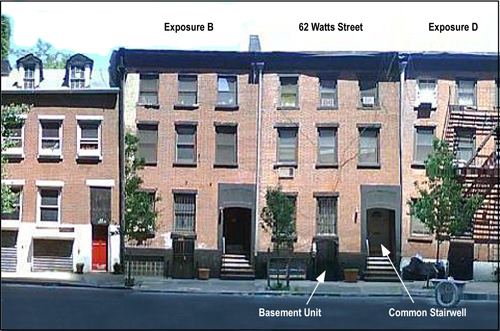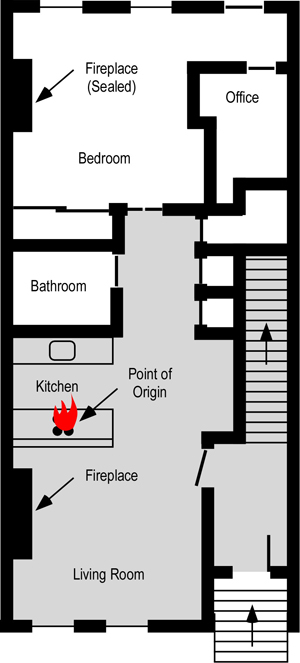15 Years Ago:
Backdraft at 62 Watts Street
Fifteen years ago tomorrow, three members of the Fire Department of the City of New York (FDNY) lost their lives while conducting search in a three story apartment building located at 62 Watts Street in Manhattan. Captain Drennan and Firefighters Young and Seidenburg were trapped in a stairwell by rapid fire progression that occurred as other companies forced entry into the fire apartment on the floor below.
The Case
This case study was developed using a paper written by Richard Bukowski (1996) of the National Institute for Standards and Technology (NIST) Building and Fire Research Laboratory (BFRL). The FDNY requested the NIST assistance in modeling this incident to develop an understanding of the extreme fire behavior phenomena that took the lives of Captain Drennan and Firefighters Young and Seidenburg.
At 1936 hours on March 28, 1994, FDNY responded to a report of heavy smoke and sparks from a chimney of a three-story apartment building at 62 Watts Street (see Figure 1) in Manhattan. On arrival companies observesd smoke from the chimney, but no other evidence of fire. The first due engine and truck companies stretched a hoseline to the first floor unit and vertically ventilated over the stairwell.
Figure 1. 62 Watts Street-Side A

Working as the inside team of the second due truck company, Captain John Drennan (Ladder 5), Firefighter James Young, and Firefighter Christopher Seidenburg (both detailed from Engine 24 to Ladder 5) went to the second floor to begin primary search of the upper floors. At the doorway to the second floor apartment unit they were trapped by an explosion and rapid fire progression from the first floor apartment up the common stairwell. Both firefighters died within 24 hours as a result of thermal injuries. Captain Drennan survived for 40 days in the burn unit before succumbing to his injuries.
Building Information
The fire occurred in a 6.1 m (20′) x 14 m (46′), 3 ½ story apartment building of ordinary (Type III) construction, containing four dwelling units (the basement apartment was half below grade). Each unit had a floor area of slightly less than 81.7 m2 (880 ft2). The basement unit had its own entrance and the units on Floors 1-3 were served by a common stairwell on Side D of the building (see Figure 1). Exposure B was an attached building identical to the fire structure. Exposure D was a similar structure. Neither exposure was involved.
Figure 2. Floor Plan-First Floor Apartment

Note: Adapted from Modeling a Backdraft Incident: The 62 Watts St. (NY) Fire.
The building was originally built in the late 1800s and had undergone numerous renovations. Recent renovations involved replacement of plaster and lath compartment linings with drywall over wood studs and lowering of the ceiling height from 2.8 m (9’3″) to 2.5 m (8’4″). All apartments had heavy wood plank flooring. During the latest renovation, windows and doors were replaced and extensive thermal insulation added to increase energy efficiency. The building was originally heated with the use of multiple fireplaces in each apartment. However, most of these had been sealed shut. However, the fireplace in the living room of the first floor apartment (unit of origin) was operable and had a 0.209 m2 (2.25 ft2) flue.
All apartments had similar floor plans (differences resulting from location of the stairwell). The floor plan of the first floor apartment (unit of origin) is illustrated in Figure 2. Each apartment consisted of a living room, kitchen, bathroom, and bedroom. The first floor unit had an office constructed within the bedroom.
The structure had a flat roof with a scuttle and skylight over the stairwell.
The Fire
The occupant left the first floor apartment at 1825 hours, leaving a plastic trash bag on top of the gas fired kitchen range (see Figure 2). Investigators deduced that the bag was ignited by heat from the pilot light. Fire extended from the bag of trash to several bottles of high alcohol content liquor located on the counter adjacent to the stove. The fire progressed into the growth stage, involving other fuel packages within the apartment. The apartment was tightly sealed with the only sources of ventilation being the open fireplace flue and minimal normal building ventilation.
Weather Conditions
The weather was 10o C (50 o F) with no appreciable wind.
Conditions on Arrival
On arrival companies observed smoke from the chimney of the apartment building, but no other signs of fire from the exterior.
Firefighting Operations
The outside team from the first due truck went to the roof and opened the scuttle over the stairwell while the first arriving engine company stretched a hoseline to the interior and prepared to make entry into the first floor apartment along with the inside team from the ladder company. Ladder 5 was the second due truck. The inside team from Ladder 5, Captain Drennan, Firefighter Young, and Firefighter Seidenburg, went to the second floor to begin primary search.
When the first due engine and truck forced the door to the first floor apartment they observed a pulsing air track consisting of an inward rush of air followed by an outward flow of warm (not hot) smoke. This single pulsation was followed by a large volume of flame from the upper part of the door and extending up the stairwell.
Figure 3. 3D Cutaway View of 62 Watts Street

Note: Adapted from Modeling a Backdraft: The 62 Watts Street Incident.
The crews working on Floor 1 were able to escape the rapid fire progression, but Ladder 5’s inside team was engulfed in flames which filled the stairwell. Flames extended from the doorway of the first floor apartment through the stairwell and vented out the scuttle opening and skylight. This flaming combustion continued in excess of 6 minutes 30 seconds. The intense fire in the stairwell severely damaged the stairs and melted the wired glass in the skylight.
Questions
The following questions focus on fire behavior, influence of tactical operations, and related factors involved in this incident.
- Other than smoke and sparks from the chimney, what B-SAHF indicators might have been present and visible from the exterior or at the doorway that may have provided an indication of conditions inside the apartment?
- What do you make of the observations of the company making entry to the first floor apartment for fire attack? Is this consistent with your understanding of backdraft indicators? Why or why not?
- What steps can you take when making entry if you suspect that the fire is ventilation controlled? How would this change if you suspected or saw indicators of potential backdraft conditions?
- Firefighters often identify vertical ventilation when given a scenario where backdraft indicators are present. If there is value (savable people or property) and the fire is on a lower floor (as it was in the Watts Street incident), what tactical options are available to mitigate the hazards of potential backdraft conditions?
Analysis and Computer Modeling
My next post will examine the results of this investigation and how the computer modeling performed by NIST contributes to our understanding of the events that took the lives of Captain Drennan and Firefighters Young and Seidenburg.
Ed Hartin, MS, EFO, MIFIreE, CFO
Tags: B-SAHF, backdraft, case study, Extreme Fire Behavior, fire behavior indicators, firefighter fatality, NIST, practical fire dynamics, reading the fire, situational awareness, structural firefighting, vent controlled fire



May 14th, 2013 at 09:54
[…] Other fallen former company members include Lt. Charles Hunt of Staten Island Engine 166 who died on duty in 1977, and Capt. John J. Drennan Jr. of Greenwich Village Ladder Company 5, who along with company members Christopher Siedenburg and James Young, died as a result of 1994′s infamous Watts Steet Fire. […]
September 11th, 2013 at 19:11
The box response was reported to be a top floor fire at 60 Watts Street…..it was only after investigation at the scene units realized the fire was at 62 Watts Street on the 1st floor…